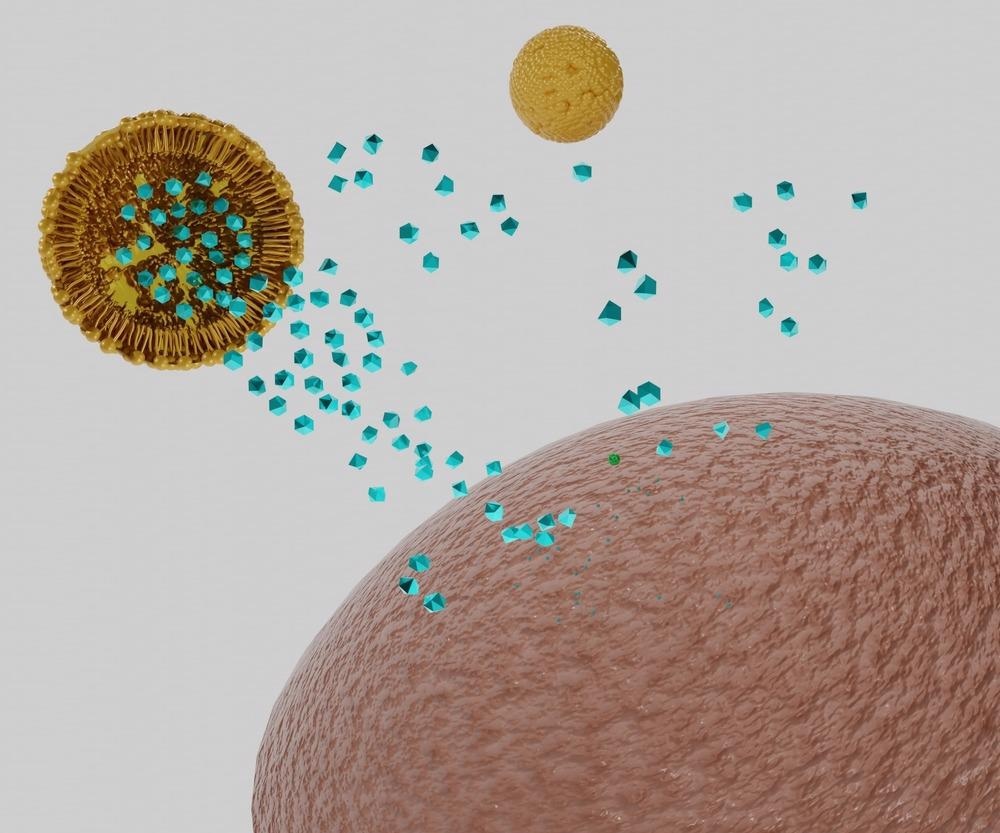The latest research in the Chemical Engineering Journal focuses on a sophisticated two-dimensional (2D) photonic drug-delivery technology based on PEGylated WO2.9 nanosheets (a substoichiometric version of WO3) (NSs).

Study: Oxygen-deficient tungsten oxide perovskite nanosheets-based photonic nanomedicine for cancer theranostics. Image Credit: Love Employee/Shutterstock.com
Photothermal Therapy and 2D Nanomaterials Perovskite
Photothermal therapy (PTT), a non-invasive technique of tumor treatment that employs photothermal agents (PTAs) to create local hyperthermia using near-infrared (NIR) laser light, has been extensively researched and has garnered considerable focus.
Perovskite nanosheets offer several appealing traits as 2D nanomaterials, including surface area features, mechanical flexibility, strong light-matter interaction, minimal trap-state density, and higher adsorption efficacy. Some perovskite nanosheets exhibit high photoluminescence.
Limitations
However, because of the restricted tissue depth of penetration of the typical NIR-I bio-window (650–950 nm), most PTT mediated by NIR-I is still insufficient for the effective treatment of big or severe tumors, contributing to an elevated remnant and recurrence rate.
In comparison, the NIR-II (1000–1700 nm) bio-window had a higher maximum permitted exposure (MPR), decreased photon scattering, increased penetration depth, and reduced tissue background, allowing NIR-II PTT to significantly enhance tumor treatment efficiency. Unfortunately, in comparison to the PTA active in the NIR-I region, the advancement of NIR-II materials is still behind.
Materials Incorporated
The materials used by the researchers for the experiment included Sodium tungstate monohydrate (Na2WO4⋅H2O), nitric acid (HNO3), chloroform (CHCl3) sodium borohydride (NaHB4), doxorubicin hydrochloride (DOX), calcein-AM, Propidium Iodide (PI), 4′,6-diamidino-2- phenylindole (DAPI), and CCK-8.
Phosphate-buffered saline (PBS) (pH 7.4), cell culture medium, fetal bovine serum (FBS), penicillin-streptomycin, and trypsin-EDTA were also utilized during the research study.
Research Methods
Transmission electron microscopy, scanning electron microscopy, and atomic force microscopy was utilized for the research study.
First, 200 mg of Na2WO4H2O were scattered in 300 mL of HNO3 solution (5 M). The combined mixture was then swirled for three days at room temperature (RT) for bulk production of WO3⋅H2O. Two rectangle porcelain crucibles with a volume of 5.0 cm × 2.0 cm × 1.5 cm were used. Firstly, 10 mg of WO3⋅H2O NSs was placed in one of them, NaBH4 (5 mg) was placed in the other one. Two porcelain crucibles were then placed in a tubular furnace, and the porcelain crucibles containing WO3⋅H2O NSs were held on top of the other with a rotation angle of 20°.
To make PEG-coated WO2.9 NSs, WO2.9 NSs (10 mg) were combined with 25 mg DSPE-PEG dissolved in CHCl3 solution in 30 mL CHCl3 solution. The CHCl3 solution was removed using vacuum rotary evaporation after 30 minutes of ultrasonic treatment.
Different concentrations of DOX were dissolved in PBS solution (pH 7.4, 10 mM) and further mixed with PEG@WO2.9 NSs. The final concentration of DOX was 0.2, 0.4, 0.6, 0.8 and 1 mg mL− 1, respectively.
In the DMEM medium, 4 T1 cells, HUVEC cells, NCM-460 cells, and Hela cells were incubated. FBS (10%) and streptomycin/penicillin (1%) supplements were administered to all of the DMEM media for the generation of cell cultures.
Results and Discussion
The latest study showed that WO3⋅H2O NS exhibited the typical Raman-active peaks at 120, 267, 326, 684, 810, and 960 cm− 1. The PEGylated WO2.9 NS (PEG@WO2.9 NS) still retained good dispersity and stability in the PBS and medium even after 24 h incubation, indicating that the dispersity and stability are significantly bet.
When the quantity of PEG@WO2.9 NSs was 200 mg mL 1, the greatest temperature generated by 2.0 Wcm2 NIR-I irradiation was only 32.2 °C. Under 808 nm and 1064 nm irradiation, the photothermal conversion efficiency of PEG@WO2.9 NSs is determined to be 18.7 percent and 36.2 percent, respectively. These findings imply [email protected] NSs have a high potential for use as a photothermal agent for PTT against tumors in the NIR-II window.
The medication loading capacity of [email protected] NSs was then examined using a UV–vis absorption spectrum. The concentration of DOX loaded onto [email protected] increased with the addition of the concentration of DOX, and the maximum drug load efficiency was approximately 102 percent at our studied parameters, which is significantly higher than most nanoparticle-based delivery platforms with drug-loading capacities of 10%–30%.
In all cases, four T1 cells were co-cultured. There was no evident cytotoxicity in the groups that simply received NIR-II or PEG@WO2.9 therapy. Hence, both nontoxicity and biocompatibility were confirmed.
Future Trends
Keeping in view the incredible findings, the WO2.9-based nanoplatform may open the way for a novel method to use more effective perovskite theragnostic nanomedicines for the cure of diverse solid cancers.
In short, 2D perovskite nanosheet drug delivery has been proved to be not only biocompatible but also quite effective for cancer treatment, revolutionizing biomedical applications of such materials and improving the health care treatment quality for people.
References
Zhang, L., Zhao, S., Ouyang, J., Deng, L., & Liu, Y. N. (2021). Oxygen-deficient tungsten oxide perovskite nanosheets-based photonic nanomedicine for cancer theranostics. Chemical Engineering Journal. https://www.sciencedirect.com/science/article/pii/S1385894721048488
Disclaimer: The views expressed here are those of the author expressed in their private capacity and do not necessarily represent the views of AZoM.com Limited T/A AZoNetwork the owner and operator of this website. This disclaimer forms part of the Terms and conditions of use of this website.